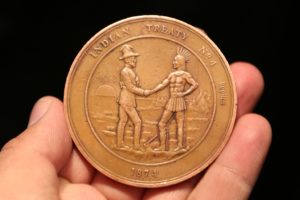History & Mandate

Assembly of Manitoba Chiefs and the MIB Early Beginnings
The Assembly of Manitoba Chiefs was created in 1988 by First Nations in Manitoba to coordinate political action and technical work on common issues. It is a product of political and social developments that have been underway for decades. Faced with the domination and assimilation policies of Canada’s Department of Indian Affairs, First Nations have long recognized their common interests and the strength to be found in solidarity. Creating an organization able to accommodate the linguistic, cultural and geographic diversity of First Nations has been a significant accomplishment.
The AMC’s predecessor was the Manitoba Indian Brotherhood (MIB). Early efforts at province-wide organization culminated in the creation of MIB in the late 1960s. It provided a representative political body based on regionally elected vice presidents and a president who provided the first familiar voice for First Nations in the province. MIB (later renamed the First Nations Confederacy) endured an intense struggle to gain recognition of Treaty and Aboriginal Rights in Canadian courts and legislatures and begin developing and healing First Nations. By the early 1980s, the strains of an increasingly complex agenda and emerging regional interests led to the dissolution of the province-wide body.
For a number of years, common interests of First Nations in Manitoba were pursued through less formal cooperative efforts of First Nations, Tribal Councils, and the regional political organizations of Manitoba Keewatinowi Okimakinak (northern Chiefs), and First Nations Confederacy (a coalition of several southern Tribal Councils).
In the intervening years, the merits and practical requirements for province-wide political cooperation continued to be discussed. By 1987, an All Chiefs Unity Assembly had convened to adopt by consensus a statement of principles of political unity. The following year the Chiefs-in-Assembly ratified a model for political coordination and cooperation which set out the basic structure and mandate for the Assembly of Manitoba Chiefs and its Secretariat. Louis Stevenson was appointed as the first provincial Leader of the Assembly of Manitoba Chiefs in 1987.
AMC remains true to the original model, which aimed to provide a mechanism to balance respect for local and regional autonomy with the need for collective positions and decisions. It has been structured and mandated to provide a forum for discussion, coordination and consensus building. It is intended to be comprehensive in terms of the scope of issues and integration of political and technical institutions of First Nations.
In 1990, a certified resolution gave the title to the first Grand Chief of the Assembly of Manitoba Chiefs. Phil Fontaine became the first person to carry the title of Grand Chief of AMC.
The Grand Chief, elected by Chiefs-in-Assembly, is mandated as the principal spokesperson on common issues for First Nations in Manitoba. While AMC functions under the direction of the Grand Chief, the Chiefs-in-Assembly are the source of all authority for AMC.
The role of the AMC is essentially political. Internally, the organization functions to build consensus on issues and priorities. Externally, the AMC presents a common front in pursuing issues in many different ways.
Since 1988, the AMC agenda and priorities and the capacity of its Secretariat have developed, expanded and evolved. Today, the AMC is governed by the mandate set out by 62 member First Nations and advocates in several policy sectors, including child and family services, health, education, citizenship, gaming, Jordan’s Principle, social development, urban and Treaties.

Our Mandate
The mandate of the Assembly of Manitoba Chiefs, is through the Chiefs-in-Assembly, to devise collective and common political strategies and mechanisms for coordinated action by First Nations and their organizations to:
- Promote, preserve, and protect Aboriginal and Treaty rights for First Nation people in Manitoba;
- Preserve and enhance the rights and freedoms of First Nations in Manitoba as distinct peoples;
- Strengthen and restore the foundations of First Nation cultures, traditions, languages, economies, and societies;
- Affirm First Nation rights as peoples to exercise and practice self-determination and self-government;
- Protect the integrity and authority of each First Nation’s customs, laws, and practices; and
- Preserve and enhance the role of equal participation of First Nation women within political, economic, and social spheres of First Nation governments and organizations.
AMC Constitution
Click here to read the AMC Constitution.
